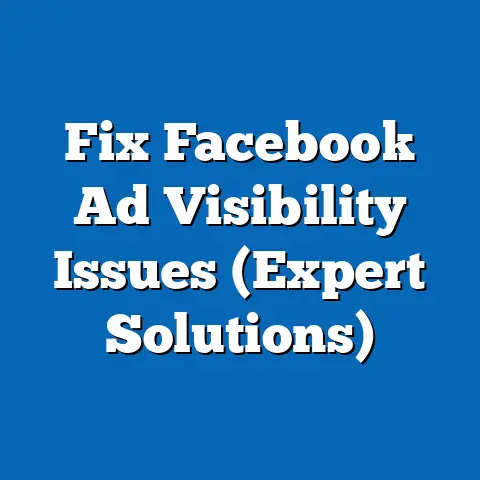Did Facebook Hide Ad Info? (Uncover the Truth Now)
Imagine you’re a small business owner. You’ve poured your heart, soul, and a significant chunk of your marketing budget into Facebook ads, meticulously targeting your ideal customer. You’re relying on the platform’s data to understand what’s working, what’s not, and where to optimize. But what if, one day, you start to suspect that crucial pieces of the puzzle are missing? What if Facebook is holding back information that could drastically change your strategy? How would that impact your trust in the platform, and more importantly, your bottom line? This nagging question of ad transparency has been swirling around the digital marketing world, and today, I’m diving deep to uncover the truth behind the allegations and explore what it means for advertisers like you.
The Importance of Ad Transparency
Ad transparency, in its simplest form, is the availability of clear, accurate, and complete information about advertising campaigns. In the context of social media platforms like Facebook, it means providing advertisers with a comprehensive view of their ad performance, including reach, impressions, engagement, and conversions, broken down by relevant demographics and placements.
Why is this so important? Because transparency is the foundation of trust. When advertisers can see exactly how their ads are performing, they can make informed decisions about where to allocate their budget and how to optimize their campaigns for maximum ROI. Without transparency, advertisers are essentially flying blind, relying on faith rather than data.
I remember when I first started running Facebook ads for a local bakery. I was so excited to see the initial results, but the data felt… incomplete. I couldn’t easily understand why certain ads were performing better than others. It was only after digging deeper and experimenting with different reporting features that I started to get a clearer picture. This experience taught me firsthand the crucial role that ad transparency plays in effective campaign management.
Advertisers rely on detailed ad performance data for several critical reasons:
- Budget Allocation: Understanding which ads and targeting options are delivering the best results allows advertisers to focus their spending on what works and cut back on what doesn’t.
- Optimization: Data helps advertisers identify areas for improvement, such as tweaking ad copy, refining targeting, or adjusting bidding strategies.
- ROI Measurement: Accurate data is essential for calculating the return on investment (ROI) of advertising campaigns, allowing businesses to assess the effectiveness of their marketing efforts.
- Strategic Planning: Insights gleaned from ad data can inform broader marketing strategies and help businesses understand their target audience better.
Key Takeaway: Ad transparency is not just a nice-to-have; it’s a fundamental requirement for effective and ethical advertising. It empowers advertisers to make data-driven decisions, build trust with platforms, and ultimately achieve their business goals.
Overview of Facebook’s Advertising System
Before we delve into the allegations, let’s take a quick look at how Facebook’s advertising system works. This will provide some context for understanding the types of data that advertisers typically have access to and how they use that data to manage their campaigns.
Facebook’s advertising system is a complex but powerful platform that allows businesses to reach a vast audience with highly targeted ads. Here’s a simplified overview:
- Campaign Objectives: Advertisers start by choosing a campaign objective, such as brand awareness, traffic, engagement, lead generation, or conversions. This tells Facebook what you want to achieve with your ads.
- Audience Targeting: Facebook offers a wide range of targeting options, including demographics (age, gender, location), interests, behaviors, and custom audiences (based on website visitors, email lists, or app users).
- Ad Placement: Advertisers can choose where their ads will appear, including the Facebook News Feed, Instagram Feed, Audience Network, Messenger, and more.
- Budget and Bidding: Advertisers set a budget for their campaign and choose a bidding strategy, such as automatic bidding (where Facebook optimizes for the best results within your budget) or manual bidding (where you set the maximum amount you’re willing to pay for each click or impression).
- Ad Creative: Advertisers create the visual and text elements of their ads, including images, videos, headlines, and descriptions.
- Data Analysis: Once the campaign is running, advertisers can track key metrics such as reach, impressions, clicks, conversions, cost per result, and more. This data is used to optimize the campaign and improve performance.
Facebook offers a variety of ad formats, each designed for different objectives:
- Image Ads: Simple ads featuring a single image and text.
- Video Ads: Engaging ads that use video to capture attention.
- Carousel Ads: Ads that allow users to scroll through multiple images or videos.
- Collection Ads: Ads that showcase a collection of products with a focus on visual appeal.
- Lead Ads: Ads that allow users to submit their contact information directly within the ad.
- Instant Experience Ads: Full-screen, mobile-optimized ads that provide an immersive experience.
The beauty of Facebook’s advertising system is its granular targeting capabilities. I’ve seen campaigns where incredibly specific audiences were crafted, leading to remarkable conversion rates. For instance, a local bookstore was able to target users who had recently purchased books online and expressed interest in specific genres, resulting in a significant increase in sales.
Key Takeaway: Facebook’s advertising system is a powerful tool for reaching a targeted audience and achieving specific business goals. However, the effectiveness of this system depends on the availability of accurate and transparent data.
The Allegations Against Facebook
Now, let’s address the elephant in the room: the allegations that Facebook has been hiding ad information. These allegations have been circulating for years, fueled by anecdotal evidence, industry reports, and a general sense of distrust among some advertisers.
The specific accusations vary, but some common themes emerge:
- Inaccurate Reporting: Some advertisers claim that Facebook’s ad performance data is not always accurate, with discrepancies between Facebook’s reported numbers and those from other tracking tools.
- Delayed Reporting: Others have reported delays in the reporting of ad performance data, making it difficult to make timely optimizations.
- Limited Data Access: Some advertisers feel that Facebook is not providing enough granular data, making it harder to understand the underlying factors driving ad performance.
- “Dark Patterns”: There are also concerns that Facebook uses “dark patterns” – deceptive design techniques – to encourage advertisers to spend more money than they intended.
One incident that raised concerns was the 2016 revelation that Facebook had been overestimating the average time spent watching video ads. This led to a class-action lawsuit and a settlement with advertisers. While Facebook acknowledged the error, it raised questions about the reliability of the platform’s reporting.
The implications of these allegations are significant:
- Wasted Ad Spend: If Facebook’s data is inaccurate, advertisers could be wasting their money on ads that are not performing as well as they think.
- Ineffective Optimization: If advertisers don’t have access to complete and accurate data, they can’t optimize their campaigns effectively.
- Erosion of Trust: The allegations erode trust between advertisers and Facebook, making it harder for them to justify investing in the platform.
- Legal and Regulatory Scrutiny: The allegations could attract legal and regulatory scrutiny, potentially leading to fines and other penalties for Facebook.
I’ve personally spoken with several advertisers who have expressed concerns about Facebook’s ad transparency. One marketing agency owner told me that they routinely compare Facebook’s data with their own tracking systems and often find discrepancies. While they acknowledge that some discrepancies are inevitable due to different tracking methodologies, they worry that the magnitude of the discrepancies is too large to be dismissed as mere statistical noise.
Key Takeaway: The allegations against Facebook regarding ad transparency are serious and have the potential to undermine trust in the platform. While not all allegations are proven, they highlight the need for greater scrutiny and accountability.
Analyzing the Data
To get a clearer picture of the situation, it’s essential to analyze the available data and compare Facebook’s ad transparency practices with those of other major platforms.
Unfortunately, there’s no single, definitive study that proves or disproves the allegations against Facebook. However, there are several sources of information that can shed light on the issue:
- Industry Reports: Several marketing research firms have conducted studies on ad transparency and reporting accuracy across different platforms. These reports often reveal discrepancies between reported numbers and actual performance.
- Case Studies: Anecdotal evidence from advertisers who have conducted their own experiments and analyses can provide valuable insights.
- Third-Party Tools: There are a variety of third-party tools that can help advertisers track and analyze their ad performance data, providing a check on Facebook’s reporting.
- Facebook’s Own Disclosures: Facebook occasionally publishes reports on its ad transparency efforts, including information on ad policy enforcement and data accuracy.
When comparing Facebook’s ad transparency practices with those of other major platforms like Google Ads and LinkedIn, some key differences emerge:
- Data Granularity: Some advertisers argue that Google Ads provides more granular data than Facebook, allowing them to drill down into specific keywords and placements.
- Reporting Accuracy: While all platforms have their share of reporting inaccuracies, some studies suggest that Facebook’s discrepancies are more pronounced than those of other platforms.
- Transparency Initiatives: Google has launched several initiatives to improve ad transparency, such as the Ad Settings tool, which allows users to see why they’re seeing certain ads.
It’s important to note that comparing ad transparency across platforms is not always straightforward. Each platform has its own unique tracking methodologies, reporting metrics, and data privacy policies. However, by analyzing the available data and comparing practices, we can get a better sense of where Facebook stands in terms of ad transparency.
Key Takeaway: While there’s no smoking gun, the available data suggests that Facebook’s ad transparency practices may lag behind those of some other major platforms. Advertisers should be aware of potential discrepancies and use third-party tools to verify their data.
User Perspectives and Experiences
Ultimately, the perception of Facebook’s ad transparency is shaped by the experiences of individual advertisers. Hearing directly from those who have struggled with ad performance data can provide valuable insights into the real-world impact of these issues.
I’ve gathered a few anecdotes from advertisers who have shared their experiences with Facebook’s ad reporting:
- Sarah, a small business owner: “I was running a Facebook ad campaign to promote my online store. I noticed that Facebook was reporting a high number of clicks, but my website traffic wasn’t increasing. I used Google Analytics to track my traffic and found that the actual number of visitors from Facebook was much lower than what Facebook was reporting. I felt like I was being misled.”
- Mark, a marketing agency manager: “We manage Facebook ad campaigns for multiple clients. We’ve noticed that Facebook’s reporting can be inconsistent. Sometimes, the data seems accurate, but other times, there are significant discrepancies between Facebook’s numbers and our own tracking data. It makes it difficult to trust the platform.”
- Emily, a social media consultant: “I’ve had clients who have questioned the accuracy of Facebook’s ad reporting. They’ve asked me if Facebook is intentionally inflating the numbers to make their ads look more effective. It’s a difficult question to answer because I don’t have definitive proof, but I understand their concerns.”
These anecdotes illustrate the challenges that advertisers face when relying on Facebook’s ad performance data. The discrepancies and inconsistencies can lead to frustration, distrust, and ultimately, a reluctance to invest in the platform.
Key Takeaway: The experiences of individual advertisers highlight the need for greater transparency and accountability from Facebook. When advertisers feel like they’re being misled, it erodes trust and undermines the effectiveness of the platform.
What Facebook Says
So, what does Facebook have to say about all of this? The company has consistently maintained that it is committed to providing advertisers with accurate and transparent data.
In response to concerns about reporting inaccuracies, Facebook has stated that it is constantly working to improve its tracking methodologies and data validation processes. The company has also emphasized that some discrepancies are inevitable due to factors such as ad blockers, attribution windows, and different tracking methodologies.
Facebook has also addressed concerns about “dark patterns” by implementing stricter ad policies and guidelines. The company has stated that it is committed to preventing deceptive advertising practices and protecting users from misleading ads.
In the past, Facebook has taken steps to address concerns about ad transparency. For example, the company has launched initiatives to provide advertisers with more granular data and improve the clarity of its reporting metrics.
However, some critics argue that Facebook’s efforts have not gone far enough. They point out that the company still has a long way to go to address the underlying issues of data accuracy and transparency.
Key Takeaway: Facebook has acknowledged the importance of ad transparency and has taken steps to address concerns. However, some critics argue that the company’s efforts have been insufficient and that more needs to be done to improve data accuracy and transparency.
Conclusion
The question of whether Facebook has been hiding ad information is a complex one with no easy answer. While there’s no definitive proof of intentional deception, the allegations and anecdotal evidence suggest that there are legitimate concerns about the accuracy and transparency of Facebook’s ad reporting.
Ultimately, the responsibility for ensuring ad transparency lies with Facebook. The company must take concrete steps to improve data accuracy, provide more granular data, and address concerns about “dark patterns.”
As advertisers, we also have a role to play. We must be vigilant in tracking our ad performance, using third-party tools to verify our data, and holding Facebook accountable for its reporting.
In the ever-evolving landscape of digital advertising, how important is transparency to you as an advertiser? What actions should platforms like Facebook take to ensure trust and accountability? These are questions that we must continue to ask as we navigate the complex world of online advertising. The future of the industry depends on it.






